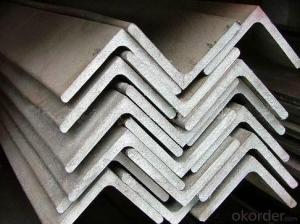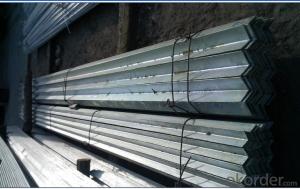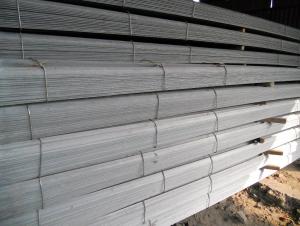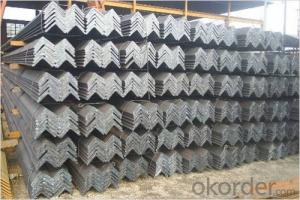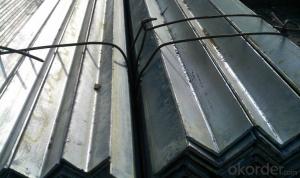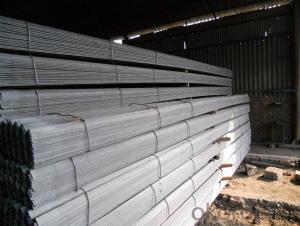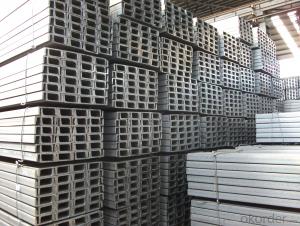S235 S355 SS400 A36 Q235 Q345 Construction Structural Hot Rolled Angle Iron or Equal Angle Steel
- Loading Port:
- Tianjin
- Payment Terms:
- TT OR LC
- Min Order Qty:
- 25 m.t.
- Supply Capability:
- 30000 m.t./month
OKorder Service Pledge
OKorder Financial Service
You Might Also Like
Packaging & Delivery
| Packaging Detail: | standard sea worhy package in bundles or at customer's request |
| Delivery Detail: | within 30 days after receive the deposit |
Specifications
Construction structural hot rolled Angle steel
size : 20*20 - 200*200 mm
Thickness : 3-20 mm
Material :S235 S355 SS400 A36
Construction structural hot rolled Angle steel
Product Description
Angle steel is commonly known as angle , its the long shape steel that both sides each other into vertical angle . Divided into equal angle and unequal angle .According to the stress of the structure of the different needs , angles can make into various components , also can make members between the joints widely used in various building structure , such as the beam , bridges , transmission , tower , lifting transportation machinery , ship , industrial furnace , reaction tower , container frame and warehouse .
Product Description
Angle steel is widely used in various building structure and engineering structure.
a.) beam, bridges, ship;
b.) transmission tower, reaction tower;
c.) lifting transportation machinery;
d.) industrial furnace;
e.) container frame, warehouse goods shelves, etc.
Standard | AISI, ASTM, BS, DIN, GB, JIS, etc mild angle steel |
Grade | Q235, Q345, SS400, A36, S235JR,S355JR, ST37-2,ST52, etc |
Equal Angle steel | Type: 2.5#-20# Size: 25-200mm Thickness: 3.0-20mm Weight: 0.597-71.168kg/m |
Unequal Angle steel | Type: 2.5/1.6-20/12.5 Long Side: 25-200mm Short Side: 16-125mm Thickness: 3.0-18mm Weight: 1.687-43.588kg/m |
Length | 5.8-12.0m OR according to client's request |
Element Contect | C<0.22% Si:<0.16% Mn: 0.30—0.65% P<0.060% S<0.060% |

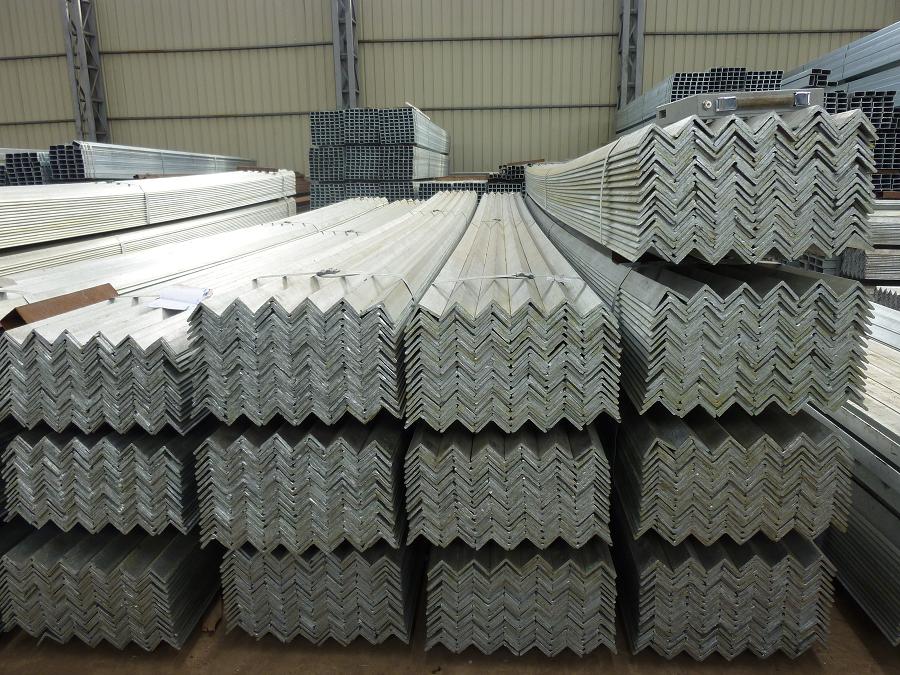
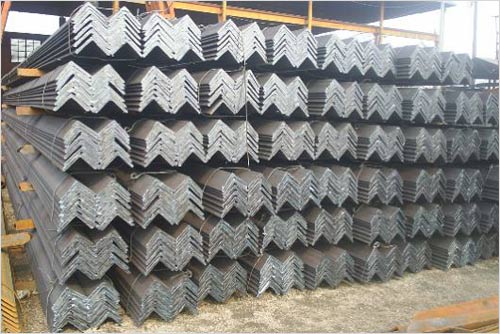
- Q: Can steel angles be used for framing or supporting exterior cladding systems?
- Yes, steel angles can be used for framing or supporting exterior cladding systems. Steel angles provide structural support and stability, making them suitable for this purpose. They can be used to create a framework or support structure for exterior cladding systems, ensuring durability and architectural integrity.
- Q: What are the guidelines for designing connections using steel angles?
- To ensure structural integrity and safety, it is important to follow certain guidelines when designing connections using steel angles. Here are some key considerations to keep in mind: 1. Load capacity: Determine the maximum load that the connection will experience, including axial and shear loads. Make sure that the chosen angle size and thickness can support these loads without any failure. 2. Angle selection: Select an appropriate size and shape of the steel angle based on the required load capacity. Common options include L-shaped angles and T-shaped angles. Also consider the material grade to ensure it meets the necessary strength specifications. 3. Welding: Welding is commonly used for connecting steel angles. Ensure that proper welding techniques are used and that the welds are of high quality. The strength of the weld should be at least equal to that of the angles being connected. 4. Bolting: Bolting can also be used for connections. Choose suitable bolts, nuts, and washers that meet the required strength and corrosion resistance. Follow recommended bolt tightening procedures to achieve the desired clamping force. 5. Connection details: Consider the type of connection required, such as moment connections, shear connections, or bracing connections. Each type has specific design requirements and detailing considerations. Adhere to industry standards and codes for proper connection design. 6. Clearances: Provide ample clearances between connected members to facilitate easy fabrication and construction. Ensure that there is enough space for welding, bolting, and necessary inspections. 7. Corrosion protection: Take into account the potential for corrosion in the connection design. Apply suitable coatings, like paint or galvanizing, to safeguard the steel angles from rusting and deterioration over time. 8. Design checks: Conduct structural analysis and design checks to verify the adequacy of the connection design. This may involve examining stress concentrations, deflections, and stability requirements. 9. Fabrication and inspection: Ensure that the connection is fabricated and constructed according to the design specifications. Regularly inspect the connections during fabrication and construction to ensure compliance with the design requirements. By adhering to these guidelines, designers can create steel angle connections that are safe, reliable, and capable of meeting the necessary load capacity and structural integrity for various applications.
- Q: Can steel angles be used in the construction of staircases?
- Yes, steel angles can be used in the construction of staircases. Steel angles provide structural support and stability, making them a suitable choice for building staircases.
- Q: Are there any specific design considerations when using steel angles?
- There are several important factors to consider when using steel angles in design. Firstly, it is crucial to assess the load-bearing capacity of the steel angles. These angles are often used in structural applications where they must bear heavy loads. Therefore, it is vital to determine the required strength and stiffness of the angles based on the anticipated loads and design requirements. Secondly, it is necessary to carefully design the connections between the steel angles and other structural elements. These connections must be strong and secure. Various methods, such as bolting, welding, or using additional plates or brackets, can be employed to ensure the stability and integrity of the connections. In addition, the stability of the steel angles themselves must be taken into account. Long and slender steel angles can be susceptible to lateral-torsional buckling when subjected to bending loads. Therefore, appropriate measures, such as bracing or increasing the section modulus, should be implemented to enhance the angles' stability. Furthermore, steel angles may be prone to corrosion, particularly in outdoor or corrosive environments. To prevent or minimize corrosion, adequate protective coatings or treatments should be applied. This will ensure the long-term durability and performance of the angles. Lastly, when using steel angles in architectural or design applications, aesthetic considerations may also be important. The appearance of the angles, including the surface finish or color, should be taken into account to achieve the desired visual effect. To summarize, the load-bearing capacity, connection details, stability, corrosion protection, and aesthetic aspects are all crucial design considerations when working with steel angles. These factors are essential for ensuring the structural integrity, durability, and overall performance of steel angle applications.
- Q: Can steel angles be used for machine frames?
- Yes, steel angles can be used for machine frames. Steel angles are commonly used in construction and engineering applications due to their strength, versatility, and cost-effectiveness. When used in machine frames, steel angles provide structural support and stability. They can be easily welded or bolted together to create a rigid frame structure that can withstand heavy loads and vibrations. The angular shape of steel angles also allows for easy attachment of other components or accessories. Overall, steel angles are a popular choice for machine frames due to their durability and suitability for various industrial applications.
- Q: How are steel angles tested for quality and strength?
- Steel angles are tested for quality and strength through various methods, including visual inspection, measurement of dimensions, and mechanical testing. Visual inspection involves checking for any visible defects or imperfections such as cracks, surface irregularities, or rust. Measurement of dimensions ensures that the angles meet the specified size and shape requirements. Mechanical testing involves subjecting the angles to forces or loads to determine their strength, such as tensile testing to measure their resistance to pulling or bending, and hardness testing to assess their resistance to indentation. These tests help ensure that steel angles meet the desired quality and strength standards.
- Q: What is the cost of steel angles compared to other structural materials?
- Various factors, such as market conditions, availability, and specific requirements, can cause the cost of steel angles to vary in comparison to other structural materials. However, as a rule, steel angles are often seen as a cost-effective choice for structural applications. When compared to materials like concrete or timber, steel angles are generally considered more affordable due to their relatively low production costs. Steel is readily available, and advancements in production techniques have resulted in competitive pricing. Furthermore, steel angles offer an exceptional strength-to-weight ratio, enabling lighter and more cost-efficient structural designs. Compared to other metals like aluminum or stainless steel, steel angles are typically more cost-effective. While aluminum and stainless steel may have certain advantages in terms of corrosion resistance or aesthetic appeal, their production processes and material properties tend to make them more expensive. It is worth noting that the exact cost of steel angles can vary depending on specific dimensions, quality, and quantity requirements. Prices may also fluctuate due to market conditions, such as changes in raw material costs or global supply and demand dynamics. Therefore, it is advisable to consult suppliers or industry professionals for accurate and up-to-date pricing information for steel angles.
- Q: How do you calculate the deflection of a steel angle?
- To calculate the deflection of a steel angle, you would need to consider several factors and apply the appropriate formulas. The deflection of a beam or angle is typically calculated using the Euler-Bernoulli beam theory, which assumes that the beam is slender and experiences small deflections. First, you need to determine the moment of inertia (I) of the steel angle. This can be calculated using the dimensions and properties of the angle section. The moment of inertia represents the resistance of the angle to bending. Next, you should determine the applied load or force (F) acting on the steel angle. This could be a concentrated load, distributed load, or a combination of both. The load will cause a bending moment (M) on the angle. Once you have determined the moment of inertia and the bending moment, you can use the formula for deflection in a simply supported beam: δ = (5 * M * L^4) / (384 * E * I) Where: - δ is the deflection at the midpoint of the steel angle - M is the bending moment acting on the angle - L is the length of the angle - E is the modulus of elasticity of the steel material - I is the moment of inertia of the angle section By plugging in the appropriate values into the formula, you can calculate the deflection. It is important to ensure that the units are consistent and compatible when performing the calculations. However, note that this calculation assumes linear behavior and neglects factors such as shear deformation and lateral torsional buckling. For more accurate results, you may need to consider additional factors or consult engineering resources, such as design codes or software, to obtain a more precise deflection calculation.
- Q: What is the difference between galvanized and black steel angles?
- Galvanized steel angles have been coated with a layer of zinc to protect them from corrosion, while black steel angles have not been coated and are more susceptible to rusting.
- Q: Can steel angles be used for pipe supports?
- Indeed, steel angles are suitable for pipe supports. Owing to their robustness and ability to bear weight, steel angles present a reliable and long-lasting solution for bolstering pipes. The structural integrity of steel angles, combined with their L-shaped configuration, ensures exceptional stability and effortless attachment to walls, ceilings, or other structural components. Moreover, steel angles can be joined through welding or bolting to fashion tailor-made setups that cater to specific pipe support needs. The versatility, strength, and simplicity of installation make steel angles a favored option for pipe support across diverse industries, including construction, plumbing, and manufacturing.
Send your message to us
S235 S355 SS400 A36 Q235 Q345 Construction Structural Hot Rolled Angle Iron or Equal Angle Steel
- Loading Port:
- Tianjin
- Payment Terms:
- TT OR LC
- Min Order Qty:
- 25 m.t.
- Supply Capability:
- 30000 m.t./month
OKorder Service Pledge
OKorder Financial Service
Similar products
Hot products
Hot Searches
Related keywords
